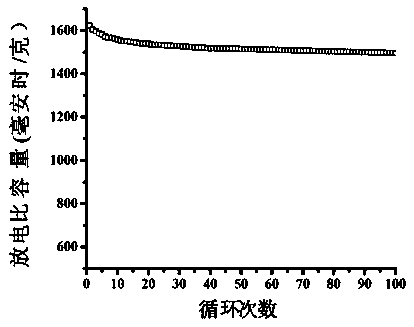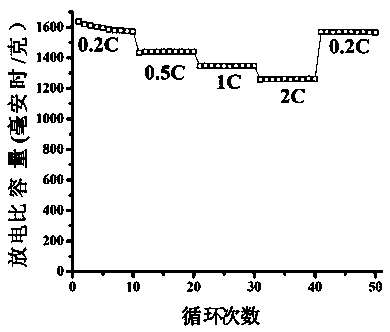Sulfur-nitrogen doped carbon nanofiber-MXene composite material for lithium-sulfur battery and preparation method thereof
A nanofiber, nitrogen-doped carbon technology, applied in the field of materials, can solve problems such as hindering the discharge reaction between electrolyte and electrode active material, increasing electrode polarization resistance, reducing battery cycle life, etc., to improve cycle stability and pore size. Small, the effect of facilitating the transmission of electrons
- Summary
- Abstract
- Description
- Claims
- Application Information
AI Technical Summary
Problems solved by technology
Method used
Image
Examples
Embodiment 1
[0027] (1) Preparation of MXene:
[0028] Dip the ground MAX phase ceramic powder into a 40% HF solution with a mass fraction of 40%. The mass ratio of the ceramic powder to the HF solution is 1:20. The temperature is raised to 60°C and magnetically stirred for 18 hours. The product is obtained by centrifugation and deionized. Wash with water to neutral, place in an oven at 70°C and dry for 18 hours to obtain MXene. The MAX phase ceramic is Ti 3 AlC 2 , Get MXene material as Ti 3 C 2 .
[0029] (2) Preparation of nitrogen-doped carbon nanofiber-MXene composite material:
[0030] Take 1.5g polyacrylonitrile, 1.5g Ti prepared in step (1) 3 C 2 , Placed in 15 mL of N,N-dimethylformamide, stirred for 18 hours and then took a homogeneous solution to prepare MXene-doped polyacrylonitrile nanofibers by electrostatic spinning. Subsequently, the prepared MXene-doped polyacrylonitrile nanofibers were placed in a tube furnace and calcined at 800°C for 3 hours in an argon atmosphere, and then ...
Embodiment 2
[0036] (1) Preparation of MXene:
[0037] Dip the ground MAX phase ceramic powder into a 30% HF solution with a mass fraction of 30%. The mass ratio of the ceramic powder to the HF solution is 1:30. The temperature is raised to 50°C and magnetically stirred for 12 hours. The product is obtained by centrifugation and deionized. Wash with water to neutral, place in an oven at 60°C and dry for 12 hours to obtain MXene. The MAX phase ceramic can be Ti 3 AlC 2 , Get MXene material as Ti 3 C 2 .
[0038] (2) Preparation of nitrogen-doped carbon nanofiber-MXene composite material:
[0039] Take 1g of polyacrylonitrile and 1g of MXene prepared in step (1), put them in 10mL of N,N-dimethylformamide, stir for 12 hours, take a homogeneous solution and electrospin to prepare MXene doped polyacrylonitrile nano fiber. Subsequently, the prepared MXene-doped polyacrylonitrile nanofibers were placed in a tube furnace and calcined at 500° C. for 2 hours in an argon atmosphere, and then cooled in th...
Embodiment 3
[0043] (1) Preparation of MXene:
[0044] Dip the ground MAX phase ceramic powder into a 50% HF solution with a mass ratio of 1:10. The temperature is raised to 90°C and magnetically stirred for 24 hours. The product is obtained by centrifugation and deionized. Wash with water to neutral, place in an oven at 80°C and dry for 24 hours to obtain MXene. The MAX phase ceramic is Ti 3 AlC 2 , Get MXene material as Ti 3 C 2 .
[0045] (2) Preparation of nitrogen-doped carbon nanofiber-MXene composite material:
[0046] Take 2g of polyacrylonitrile and 2g of MXene prepared in step (1), put them in 20mL of N,N-dimethylformamide, stir for 24 hours, take a homogeneous solution and electrospin to prepare MXene doped polyacrylonitrile nano fiber. Subsequently, the prepared MXene-doped polyacrylonitrile nanofibers were placed in a tube furnace, and calcined at 1000° C. for 5 hours in an argon atmosphere, and then cooled in the furnace to obtain a nitrogen-doped carbon nanofiber-MXene composite...
PUM
 Login to View More
Login to View More Abstract
Description
Claims
Application Information
 Login to View More
Login to View More - R&D
- Intellectual Property
- Life Sciences
- Materials
- Tech Scout
- Unparalleled Data Quality
- Higher Quality Content
- 60% Fewer Hallucinations
Browse by: Latest US Patents, China's latest patents, Technical Efficacy Thesaurus, Application Domain, Technology Topic, Popular Technical Reports.
© 2025 PatSnap. All rights reserved.Legal|Privacy policy|Modern Slavery Act Transparency Statement|Sitemap|About US| Contact US: help@patsnap.com


